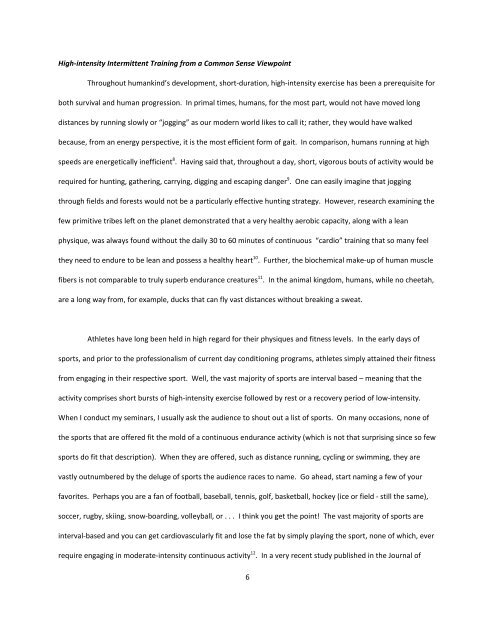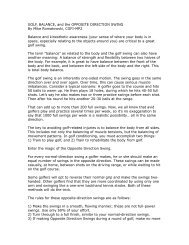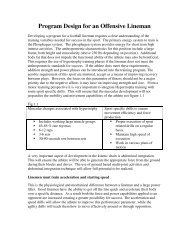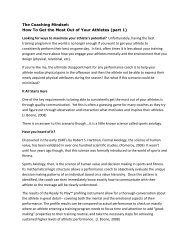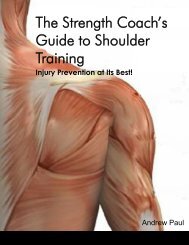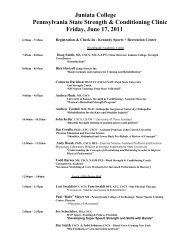Sprint Interval Training - “It's a HIIT - Strength Coach.com
Sprint Interval Training - “It's a HIIT - Strength Coach.com
Sprint Interval Training - “It's a HIIT - Strength Coach.com
You also want an ePaper? Increase the reach of your titles
YUMPU automatically turns print PDFs into web optimized ePapers that Google loves.
High‐intensity Intermittent <strong>Training</strong> from a Common Sense Viewpoint<br />
Throughout humankind’s development, short‐duration, high‐intensity exercise has been a prerequisite for<br />
both survival and human progression. In primal times, humans, for the most part, would not have moved long<br />
distances by running slowly or “jogging” as our modern world likes to call it; rather, they would have walked<br />
because, from an energy perspective, it is the most efficient form of gait. In <strong>com</strong>parison, humans running at high<br />
speeds are energetically inefficient 8 . Having said that, throughout a day, short, vigorous bouts of activity would be<br />
required for hunting, gathering, carrying, digging and escaping danger 9 . One can easily imagine that jogging<br />
through fields and forests would not be a particularly effective hunting strategy. However, research examining the<br />
few primitive tribes left on the planet demonstrated that a very healthy aerobic capacity, along with a lean<br />
physique, was always found without the daily 30 to 60 minutes of continuous “cardio” training that so many feel<br />
they need to endure to be lean and possess a healthy heart 10 . Further, the biochemical make‐up of human muscle<br />
fibers is not <strong>com</strong>parable to truly superb endurance creatures 11 . In the animal kingdom, humans, while no cheetah,<br />
are a long way from, for example, ducks that can fly vast distances without breaking a sweat.<br />
Athletes have long been held in high regard for their physiques and fitness levels. In the early days of<br />
sports, and prior to the professionalism of current day conditioning programs, athletes simply attained their fitness<br />
from engaging in their respective sport. Well, the vast majority of sports are interval based – meaning that the<br />
activity <strong>com</strong>prises short bursts of high‐intensity exercise followed by rest or a recovery period of low‐intensity.<br />
When I conduct my seminars, I usually ask the audience to shout out a list of sports. On many occasions, none of<br />
the sports that are offered fit the mold of a continuous endurance activity (which is not that surprising since so few<br />
sports do fit that description). When they are offered, such as distance running, cycling or swimming, they are<br />
vastly outnumbered by the deluge of sports the audience races to name. Go ahead, start naming a few of your<br />
favorites. Perhaps you are a fan of football, baseball, tennis, golf, basketball, hockey (ice or field ‐ still the same),<br />
soccer, rugby, skiing, snow‐boarding, volleyball, or . . . I think you get the point! The vast majority of sports are<br />
interval‐based and you can get cardiovascularly fit and lose the fat by simply playing the sport, none of which, ever<br />
require engaging in moderate‐intensity continuous activity 12 . In a very recent study published in the Journal of<br />
6


